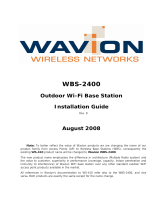Page is loading ...

Radio Mounting Options
The Altelix plastic radio adapter
works with Ubiquiti RocketM5®,
Mimosa C5c, and TP-Link WBS
Series Radios.
The Altelix metal radio adapter
works with Cambium ePMP™ series
radios.
MikroTik Basebox® can be
mounted using the holes in the L-
bracket and the screws that come
with the radio.
Other radios can be strapped directly
to the pole. Cable kits to
accommodate all radios can be found
on our website at www.altelix.com.
Copyright (C) 2017 Altelix LLC. All rights reserved. Altelix and the Altelix logo are Trademarks
and/or Registered Trademarks of Altelix LLC.
Dish Antenna
Assembly Instructions
Models: AD5G23M2, AD5G25M2
AD5G30M2
Be sure to visit WWW.ALTELIX.COM to view our complete
product information and specifications.
WARNING: INSTALLATION OF THIS PRODUCT NEAR POWERLINES IS DANGEROUS.
FOR YOUR SAFETY, FOLLOW THE INSTALLATION DIRECTIONS
Under some conditions, this antenna may not prevent electrocution. Users should keep antenna away
from any overhead wires. If antenna contacts a power line, any initial protection could fail at any time. IF
ANTENNA NEARS ANY OVERHEAD WIRES, IMMEDIATELY LET GO, STAY AWAY, AND CALL UTILITY
COMPANY
THIS ANTENNA IS DESIGNED TO BE INSTALLED ONLY BY A TRAINED PROFESSIONAL INSTALLER
Select a safe site to install the antenna.
The distance between any power lines and the installation site should be at least one and one-half times
the height of the antenna and mast assembly. Make the distance even greater, if at all possible. Since all
overhead power lines look somewhat alike, consider them all dangerous and stay well away from them.
If you have power lines in the area, call your local electric utility for assistance.
NEVER work alone; always have someone near who can summon help.
Check weather conditions. Be sure that the area is not slippery and make sure that rain or thunderstorms
are not predicted for the day you install the antenna.
The wind can blow the antenna into a nearby power line. Don't install, adjust or move antennas in
moderate or heavy winds.
If you need to use a ladder, make sure it is made of non-conductive (non-metallic) material
Antenna Installation
Properly assemble the antenna according to instructions.
If a tower or mast begins falling let go of it and let it fall.
If the antenna or any part such as the wire or mast comes in contact with power wires DO NOT TOUCH IT
OR ATTEMPT TO MOVE IT. Contact the power company for assistance.
Ground the antenna according to the National Electrical Code.
Antennas improperly installed or installed to an inadequate structure are susceptible to wind
damage that can be very serious or even life threatening. Ensure that the installation is properly
grounded. Ensure that the antenna is properly secured and structurally sound to support all loads
(weight, wind & ice) and properly sealed against leaks.
Rooftop Installation Warning
DO NOT assume that just because you're on a roof, you're isolated from ground. You may still be
electrocuted or fall off the roof.
IS0047 Rev. D 06/26/18

Step 1:
This antenna can be configured with either Horizontal/Vertical
Polarization or +/- 45 Degree Cross-Polarization.
For Horizontal/Vertical polarization, position the Feed Horn so that
the arrow label on the rear of feed horn is vertical and connector
labeled “V POL” is pointing down. Attach it to the Dish using the M4
Fasteners.
For +/- 45 Degree polarization, rotate the feed horn 45° so that the
arrow label on the rear of feed horn is as shown below. Attach it to
the Dish using the M4 Fasteners.
AD5G23M2 Installation Note:
Once feed horn is securely mounted to the dish, attached the
included radome to the front of the dish using the supplied screws.
Step 2:
Position the L-bracket on the
back of the dish as shown
above. Fasten it to the dish with
the 4 bolts provided.
Step 3:
Position the U-bolts around the
pole and feed them through the
mast clamp and L-bracket.
Tighten the nuts onto the U-
bolts to secure the setup to the
pole.
Step 4:
The antenna can be precisely
aimed using the up-down tilt
adjustments on the L-bracket.
Once the antenna is at the
required tilt angle, lock into
place using the nuts on U-bolts.
Step 5:
Connect the radio using the (2) cable assemblies provided with the
antenna.
Up-Down Tilt Adjustments
/








